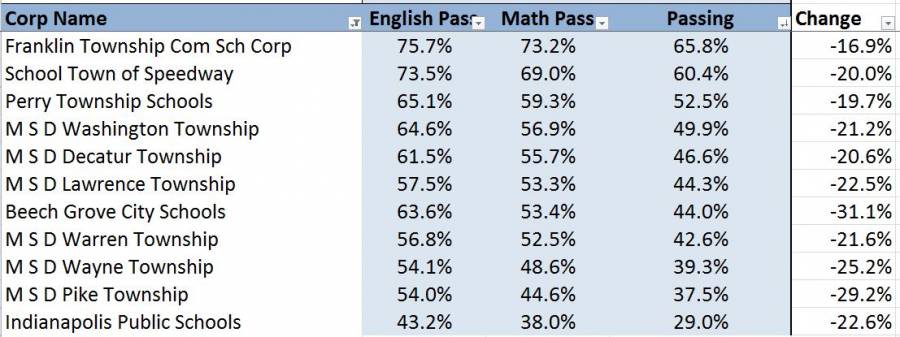
Indianapolis Mayor Joe Hogsett talks about the meeting he called with Marion County superintendents on Wednesday, Jan. 6, 2016.
Eric Weddle / WFYI Public MediaINDIANAPOLIS -- Only four out of 11 Marion County public school corporations saw half or more of their students pass both the English and math portions of the ISTEP exam. Franklin Township had the highest passage rate at nearly 66 percent. Indianapolis Public Schools was the lowest at 29 percent.
The 301 Indiana public school districts had a 22.5 percent average drop in their pass rates compared to the 2014 test results, according to data released today. The state Department of Education said scores are not comparable to previous years’ pass rates due to more difficult academic standards and the increased rigor of questions and technology enhanced items on the test.
Data: Search 2015 ISTEP+ Results By Schools
Data: Search 2015 ISTEP+ Results By School Corporation
More: ISTEP Scores Plunge For Nearly All Indiana Schools
Statewide the 2015 pass rates fell 13 points to 67 percent for math and dropped 22 points to 61 percent for English.
“After years of legislative changes at both the state and federal level, our schools were asked once again to implement new standards and subject students to a new assessment without time to transition,” state Superintendent of Public Instruction Glenda Ritz said in a statement. “The 2015 ISTEP+ results have established a new baseline for Indiana’s progress towards college and career ready benchmarks, and I want to thank our students, educators and administrators for their hard work during such a challenging school year. “
Superintendents and state education officials had warned parents and teachers to brace for drastic drop in scores. New York saw a 21 percentage point in drop in the English pass rate and a 30 percentage point decrease in the math pass rate when their new version of a state-wide test was given in 2013.
Washington Township Superintendent Niki Woodson said Marion County public schools can not rely on one annual test to grade progress for students and schools. Instead, she said, multiple type of testing and other benchmarking are given to students throughout the year to gauge academic growth.
Students in Washington Township passed math and English at a rate of 49.9 percent.
"I give the analogy to my parents, ‘If I step on a scale once a year, to determine my wellness and fitness and weight loss program, that would not be enough...and it is the same with the assessment of our students.’ ISTEP is stepping on the scale one time a year. We can not allow that to be the marker of our students."

Woodson spoke this morning after a meeting with Indianapolis Mayor Joe Hogsett and other Indianapolis school superintendents. Hogsett invited them to an hour-long, closed-door discussion on how they can work together on issues impacting schools, from poverty to teacher recruitment.
Hoggsett wouldn’t directly address the issues swirling around ISTEP, but other superintendents spoke frankly.
Warren Township’s Dena Cushenberry said much of the problems connected to ISTEP -- delays in results, testing hiccups, questions of validity -- could have been avoided if Indiana stuck with the Common Core State Standards and the standardized PAARC test, also known as the Partnership for Assessment of Readiness for College and Careers, a Common Core-based exam.
“Common Core was the way we should have gone,” said Cushenberry, whose district saw a 42.6 percent pass rate for math and English. “Nationally we can not disservice our students when it comes to SAT, money for colleges, and I think that is what we are doing. I really believe we should have stayed the Common Core tract. Our students would not have missed two or three years of education because we were flapping on what we needed to do."
In 2013 Gov. Mike Pence pulled Indiana out of the PAARC consortium and started a movement to scrap Indiana’s previous adoption of Common Core and create new math and English standards for Indiana. Soon after, the U.S. Department of Education required Indiana to administer a so-called “college and career ready” exam -- one that would be significantly different than the 2014 ISTEP. The PAARC exam would have meet the federal requirements.
By not using PAARC, Cushenberry said, it is more difficult to compare Indiana students academic achievement to other states.
Ed Week reported last year that 10 states plus Washingotn, D.C. were using PAARC and 18 other states picked a different but comparable standardized test. Twenty-one states were using their own exam.
Cushenberry estimates Indiana's academic standards written to replace Common Core are more than 90 percent the same as Common Core. Other educators and some state officials have also said the two standards are very similar.
ISTEP Scores At IPS High Schools Hit Low
Superintendent Lewis Ferebee echoed much of what was said by other superintendents. The district’s 29 percent pass rate, he said, was consistent with the 20-or-so percentage point drop seen around the state.
“We don’t believe these scores are reflective of our students and staff,” he said.
But Ferebee is worried about schools that have a history of low performance before ISTEP changes and continue on that path, such as Joyce Kilmer School 69 and Riverside School 44.
Some IPS high schools had the lowest pass rates for math and English in the state: John Marshall, 3.1 percent; Northwest, 5.8 percent, George Washington, 9.3 percent; Broad Ripple, 12.7 percent.
Arlington High School’s pass rate is 6.1 percent for 2015, when the school was operated by Tindley Accelerated Schools charter company. IPS retook control of the school last July.
Ferebee said these high schools are seeing improvements in other areas, such as graduation rates, but that the 6-12 and 7-12 grade configurations for these buildings are not working. This fall, Broad Ripple will become a 9-12 school.
The ISTEP is given to students in grades 3-8.
“I don’t think our middle grade students are being served well in that configuration,” he said.
IPS issued an open later today entitled: Staggering ISTEP Results Felt Across the State, IPS Looks Ahead.
Republican lawmakers are now discussing the possibility of requesting a rescore of the 2015 ISTEP results by a third party. That’s due to a recent Indianapolis Star report that called into question whether some tests were scored incorrectly.
Contact WFYI education reporter Eric Weddle at eweddle@wfyi.org or call (317) 614-0470. Follow on Twitter: @ericweddle.
 DONATE
DONATE







 Support WFYI. We can't do it without you.
Support WFYI. We can't do it without you.